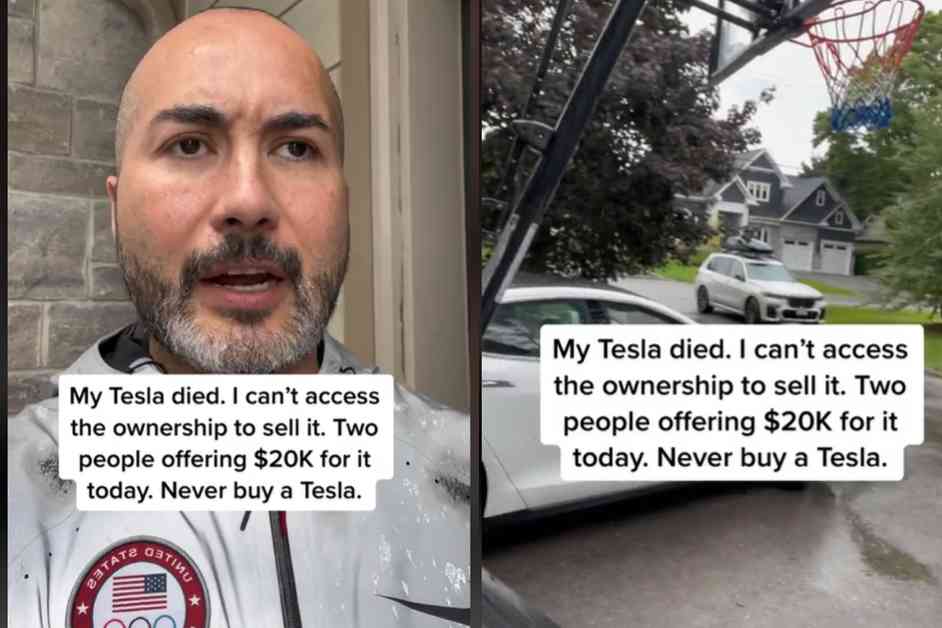Tesla Owner Forced to Sell $140K Car After Battery Lockout Issue
A Tesla owner in Canada, Mario Zelaya, recently shared his frustrating experience with his $140,000 Tesla vehicle, which left him locked out due to a battery issue. In a TikTok video that quickly went viral, Mario expressed his anger and disappointment at the situation he found himself in. This incident sheds light on the challenges that some Tesla owners face when encountering unexpected technical difficulties with their high-end electric vehicles.
The Battery Lockout Issue
Mario Zelaya’s ordeal began when he discovered that he was unable to unlock his Tesla car due to a dead battery. Unlike traditional vehicles where you can manually open the doors or seek assistance from a locksmith in case of a key-related issue, Tesla cars operate differently. The doors of a Tesla require power from the battery to function, which means that if the battery dies, accessing the vehicle becomes a major challenge.
In Mario’s case, the battery was not just drained but completely dead, rendering the car unresponsive to any attempts to unlock it. This left Mario with no choice but to look into getting a new battery for his Tesla. However, what he discovered next left him shocked and frustrated.
The Exorbitant Cost of Battery Replacement
When Mario inquired about the cost of replacing the battery in his Tesla, he was taken aback by the staggering price tag of $26,000. This unexpected expense left him feeling overwhelmed and locked out of his own vehicle. In a social media post, Mario expressed his disbelief at the high cost of a new battery, calling for better recalls and solutions to such issues in Tesla cars.
Faced with the hefty price of a battery replacement, Mario made the difficult decision to sell his Tesla car. However, this decision came with its own set of challenges. The proof of ownership papers for the vehicle were locked inside, making it impossible for Mario to proceed with the sale smoothly.
To address this obstacle, Mario had to spend an additional $30 to obtain a duplicate copy of the ownership papers before finalizing the sale of his Tesla. This unexpected turn of events further added to Mario’s frustration and disappointment with the entire experience.
Tesla’s Technical Challenges
Mario’s encounter with the battery lockout issue is not an isolated incident. In fact, several Tesla owners have reported similar problems with their electric vehicles, highlighting the ongoing technical challenges that some users face. This raises concerns about the reliability and safety of Tesla cars, despite their advanced features and innovative technology.
In a previous incident, Tesla driver Craig Doty II attributed a near-train-crash incident to the vehicle’s Full Self-Driving (FSD) mode, sparking debates about the system’s effectiveness and limitations. Another Tesla owner, Brianna Janel, found herself stuck in her car while trying to update the system in a parking lot, further emphasizing the need for improved reliability and functionality in Tesla vehicles.
Mario’s frustration with his Tesla experience reflects a growing sentiment among some owners who have encountered unexpected technical issues with their cars. As Tesla continues to innovate and expand its market presence, addressing these recurring problems becomes crucial to maintaining customer satisfaction and ensuring the overall quality and reliability of its products.
Customer Satisfaction and Quality Assurance
The incident involving Mario Zelaya’s Tesla car highlights the importance of prioritizing customer satisfaction and quality assurance in the electric vehicle industry. While Tesla has made significant strides in developing cutting-edge technologies and features, issues like the battery lockout problem underscore the need for continuous improvement and reliability testing.
As Tesla faces criticism for its high repair and replacement costs, it is essential for the company to address these concerns and provide more transparent and cost-effective solutions for its customers. Enhancing customer support services and implementing better quality control measures can help mitigate potential technical challenges and ensure a positive ownership experience for Tesla users.
In conclusion, Mario Zelaya’s experience with his Tesla car serves as a cautionary tale for both current and prospective owners of electric vehicles. While Tesla vehicles offer advanced features and performance capabilities, they are not immune to technical glitches and unexpected issues. By learning from incidents like Mario’s and taking proactive steps to improve product quality and customer satisfaction, Tesla can strengthen its position in the electric vehicle market and build lasting trust with its clientele.













